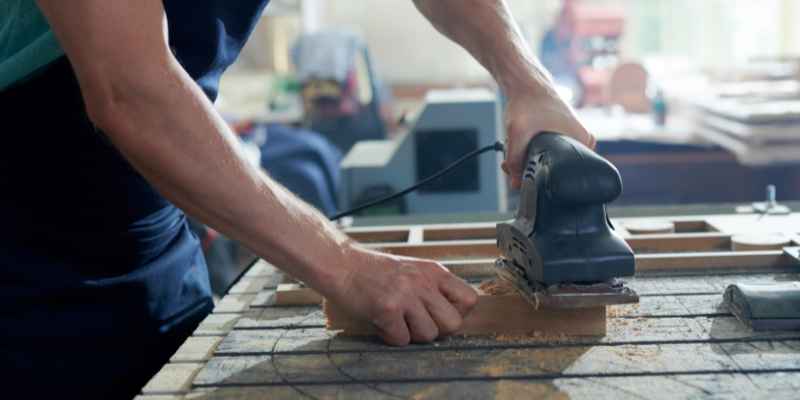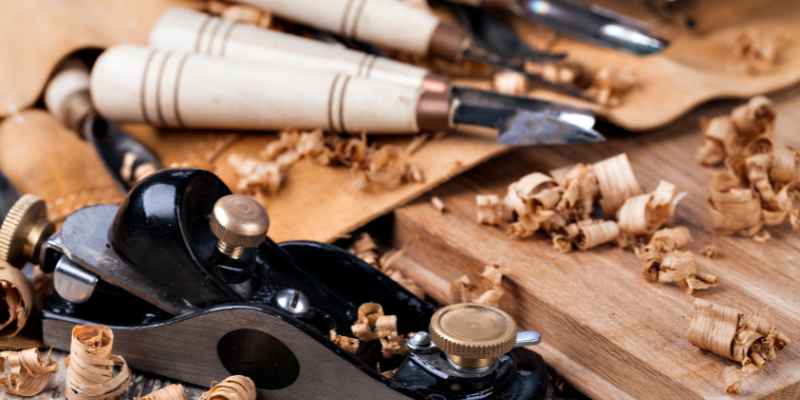To shave wood down, use hand planes that shave off thin layers of wood to shape, level, and smooth surfaces in woodworking and carpentry. Hand planes are commonly used to flatten warped wood, cut recesses, and even out surfaces to set joints flush.
They are effective tools for achieving desired wood thickness. However, if you don’t have access to a hand plane, you can clamp pieces of metal across the wood and make deep cuts along them using a knife or sharp object to shave down the wood.
This method allows you to gradually cut through the wood until you reach the desired thickness. Another option is using a sharp chisel, which can slice through wood with controlled pressure to achieve precise wood shaving.
Expert Techniques
Using Hand Planes For Wood Shaving
Hand planes are essential tools for shaving wood and are commonly used in woodworking and carpentry. These tools help in shaping, leveling, and smoothing wood surfaces by removing thin layers. They are ideal for flattening and cutting recesses in warped wood as well as creating flush joints. Hand planes require skill and precision in their usage to achieve the desired results. When using hand planes, it is important to ensure the blade is sharp and properly adjusted to effectively shave wood.
Utilizing Wood Shaving Tools
Wood shaving tools play a crucial role in the process of shaving down wood. These tools include chisels, spokeshaves, draw knives, and hand scrapers, each designed for specific wood shaving tasks. Chisels are used for precise wood shaving, while spokeshaves and draw knives are suitable for shaping and smoothing curved surfaces. Hand scrapers are effective in achieving a smooth finish on wood surfaces. Utilizing the right wood shaving tools is essential for achieving the desired wood shaping and smoothing results.
Professional Wood Shaving Machines
For large-scale wood shaving requirements, professional wood shaving machines offer efficient and precise wood shaving capabilities. These machines are designed to handle heavy-duty wood shaving tasks with accuracy and consistency. Professional wood shaving machines come in various types, including wood planers, thickness planers, and jointer-planers, each catering to specific wood shaving needs. These machines are equipped with features that ensure a high level of control and precision in wood shaving, making them ideal for industrial and commercial wood processing applications.
Key Considerations
When it comes to shaving wood down, there are a few key considerations that can greatly impact the outcome of your project. By keeping these factors in mind, you’ll be well-equipped to select the right wood and understand the grain direction for effective shaving.
Selecting The Right Wood For Shaving
Choosing the right wood is essential for a successful shaving project. Different types of wood have varying hardness and grain patterns, which can affect the ease of shaving. Here are some key points to consider when selecting wood for shaving:
- Density: Opt for wood with a moderate density that is not too soft or too hard. This will allow for smoother and more accurate shaving.
- Grain pattern: Look for wood with a straight and consistent grain pattern. This will make shaving easier and produce better results.
- Moisture content: Ensure that the wood is properly dried and has a moisture content suitable for shaving. Wood that is too damp or too dry can lead to issues such as warping or splitting during the shaving process.
Understanding The Grain Direction For Effective Shaving
The grain direction of the wood plays a crucial role in shaving. Shaving against the grain can result in tear-outs and rough finishes, while shaving with the grain provides smoother results. Here’s how to determine the grain direction and shave effectively:
- Inspect the wood: Examine the wood surface to identify the direction of the wood fibers. This can often be seen as alternating darker and lighter lines.
- Shave with the grain: Once you have determined the direction of the grain, make sure to shave in the same direction. This will help prevent tear-outs and produce a cleaner finish.
- Be mindful of irregular grain: Some woods may have irregular or interlocking grain patterns. In such cases, it may be necessary to adjust your shaving technique accordingly to accommodate for the grain direction changes.
By selecting the right wood and understanding the grain direction, you can ensure a successful shaving project with smooth and precise results. Remember to practice proper technique and always prioritize safety when working with hand planes and other wood shaving tools.
Best Practices

Safety Measures For Wood Shaving
- Always wear protective gear like safety goggles and gloves.
- Avoid loose clothing that can get caught in shaving tools.
- Keep work area well-lit and free of clutter to prevent accidents.
Maintaining Sharpness Of Shaving Tools
- Regularly sharpen the blades of your shaving tools for optimal performance.
- Use a honing guide to maintain the correct angle while sharpening.
- Store shaving tools in a dry place to prevent rusting and dulling of the blades.
Hand planes are essential for shaving off thin layers of wood in woodworking. They help in shaping, leveling, and smoothing surfaces efficiently.
One way to cut wood without a saw is by using a sharp knife or an awl to make deep cuts along the wood’s surface.
A carpenter uses a plane to smooth and true a wood surface by removing marks left by previous tools, leaving it flat, smooth, and straight.
Alternative Methods
Discover the effectiveness of hand planes for shaving wood, allowing you to shape, level, and smooth surfaces in woodworking. Hand planes are indispensable tools for flattening warped wood, cutting recesses, and ensuring joints fit seamlessly in your projects.
Using Chisels For Wood Shaving
Chisels are versatile tools that can be used for a variety of woodworking tasks, including wood shaving. When it comes to shaping and shaving wood, chisels can be an excellent alternative to traditional hand planes. With the right technique, chisels can produce smooth and precise wood shavings.
Here’s a step-by-step guide on how to shave wood using chisels:
- Start by selecting a sharp chisel that is appropriate for the task at hand. Different chisels come in various sizes and shapes, so choose one that suits your specific needs.
- Secure the piece of wood you want to shave using clamps or a vice to ensure stability.
- Hold the chisel firmly with one hand and position it at the edge of the wood.
- Apply light pressure and push the chisel forward to remove thin layers of wood. It’s important to keep the chisel at a slight angle to control the depth of the cut.
- Continue shaving the wood in even strokes, working your way along the surface. Take your time and make sure to maintain a steady hand.
- Periodically check the progress and adjust the angle and pressure as needed to achieve the desired results.
- Once you are satisfied with the wood shaving, gently brush away any debris or dust.
Exploring Block Planes As Shaving Tools
Block planes are compact hand planes that are specifically designed for woodworking tasks like wood shaving. They are lightweight, easy to handle, and perfect for trimming, smoothing, and shaping wood. Here’s how you can use a block plane for wood shaving:
- Choose a block plane that is appropriate for the size of the wood and the type of shaving you want to achieve. Block planes come with different angles, so consider your specific needs.
- Place the wood on a stable surface and firmly hold it in place.
- Hold the block plane at a slight angle relative to the surface of the wood. This will ensure smooth and controlled shaving.
- With a firm grip on the block plane, push it forward in a smooth motion along the surface of the wood. The blade should remove thin layers of wood with each pass.
- Continue to make even passes with the block plane, adjusting the angle and pressure as needed.
- Periodically check the progress and make adjustments to achieve the desired level of wood shaving.
- Once you have achieved the desired results, clean any remaining debris from the wood surface.
Using chisels and block planes as alternative methods for wood shaving can provide excellent results and allow for greater control over the shaping and smoothing process. Keep in mind that practice and patience are key to mastering these techniques. Happy woodworking!
Common Challenges

Looking to shave wood down? Hand planes are a popular tool for shaping, leveling, and smoothing surfaces in woodworking. They can flatten warped wood, cut recesses, and even out surfaces for flush joints.
Dealing With Warped Wood
When tackling warped wood, start with identifying the high points. Use a plane with sharp blades to shave down the elevated areas gradually. Work in small sections for precision.
Next, check the grain direction to prevent tear-out. Ensure consistent strokes to avoid creating dips and maintain a level surface. Constantly assess the progress for a uniform finish.
Handling Particleboard For Shaving
Particleboard requires extra care due to its composition. Begin with a low-angle plane to prevent chipping. Secure the board firmly to minimize vibrations during shaving.
Implement light passes to avoid splintering. Use a mask to protect against dust particles. Clean the plane regularly for smooth cuts and efficient shaving.
Creative Applications
Sure, here’s the HTML-formatted content for the blog post section about “Creative Applications” with the focus on the subheading “Artistic Wood Shaving Techniques”.
Wood shaving is not just a technique limited to woodworking and carpentry; it has a wide array of creative applications that can be explored for artistic and commercial purposes. From creating intricate designs to producing materials for commercial use, wood shaving offers a versatile range of possibilities.
Artistic Wood Shaving Techniques
When it comes to artistic wood shaving, there are various techniques that can be employed to create stunning works of art. Some of the artistic applications of wood shaving include:
- Wood Carving: Shavings produced from different types of wood can be utilized in intricate wood carving projects, adding depth and texture to the final piece.
- Mixed Media Art: Incorporating wood shavings into mixed media artwork can add a unique and natural element to the composition, enhancing visual appeal.
- Sculptures: Artists can use wood shavings as sculpting material, providing a sustainable alternative to traditional sculpting mediums.
Making Wood Shavings For Commercial Use
Wood shaving can also be utilized for commercial purposes, providing a sustainable and versatile material for various industries. Some of the commercial applications of wood shaving include:
- Animal Bedding: Wood shavings are commonly used as bedding material for animals, providing a comfortable and absorbent surface in agricultural and pet care settings.
- Packaging Material: The lightweight and eco-friendly nature of wood shavings makes them ideal for packaging delicate items, offering protection and cushioning during transportation.
- Biomass Fuel: Wood shavings can be compressed into dense pellets for use as a renewable and clean source of biomass fuel.
Conclusion & Safety Tips
To achieve a clean, smooth finish when shaving wood, it’s crucial to use the right tools such as hand planes. Safety tips include maintaining proper hand placement and using sharp blades to avoid splintering or uneven cuts. Additionally, always work in the direction of the wood grain for the best results.
Wrapping Up Expert Wood Shaving Techniques
Now that you have learned the fundamental wood shaving techniques, you can confidently tackle your woodworking projects with precision and finesse. Whether you are using a hand plane or wood planer, the key is to maintain a steady hand and a sharp blade to achieve the desired results. Remember, practice makes perfect, so don’t be discouraged by initial challenges.
Key Safety Tips For Wood Shaving
- Wear Protective Gear: Always use safety goggles, gloves, and a dust mask to protect yourself from wood particles and flying debris.
- Secure the Workpiece: Ensure that the wood piece is firmly secured to avoid any unexpected movement during the shaving process.
- Keep Tools Sharp: Sharp blades reduce the risk of slipping and provide cleaner cuts, so regularly sharpen and maintain your shaving tools.
- Mind Your Surroundings: Work in a well-lit and spacious area, free from obstructions, to prevent accidents and ensure better visibility.
- Follow Tool Guidelines: Adhere to the manufacturer’s guidelines for operating and maintaining your wood shaving tools to ensure safe and effective usage.
Frequently Asked Questions Of How To Shave Wood Down
What Do You Use To Shave Wood Down?
You can use hand planes to shave off thin layers of wood, shaping, leveling, and smoothing surfaces in woodworking and carpentry. They are ideal for flattening warped wood, cutting recesses, and setting joints flush.
How Do You Shave Down Wood Without A Saw?
To shave down wood without a saw, use a hand plane to remove thin layers and shape surfaces. Clamp the wood, then make deep cuts with a sharp knife or awl. A plane leaves surfaces smooth, flat, and straight, ideal for carpentry applications.
Additionally, a commercial wood shaver machine can peel off wood shavings for commercial use.
What Does A Carpenter Use To Shave Wood?
A carpenter uses a hand plane or a wood plane to shave wood. These tools shape, level, and smooth surfaces in woodworking and carpentry. They flatten warped wood, cut recesses, and even out surfaces to set joints flush. Another option is a sharp chisel, which can slice through wood with some back pressure and tapping with a hammer or mallet.
What Is The Best Tool For Making Wood Shavings?
For the best wood shavings, use a hand plane to shape, level, and smooth surfaces in woodworking. Ideal for flattening wood and setting joints flush.
Conclusion
Wood shaving is a crucial technique in woodworking and carpentry, allowing you to shape, level, and smooth surfaces. By using hand planes or a professional wood shaving machine, you can remove thin layers of wood to achieve the desired results.
Additionally, a new, sharp chisel can provide precision and control in shaving wood. Whether you are flattening warped wood or setting joints flush, these tools will help you achieve silky smooth surfaces for your woodworking projects. So, grab your tools and start creating beautiful woodwork with ease.


